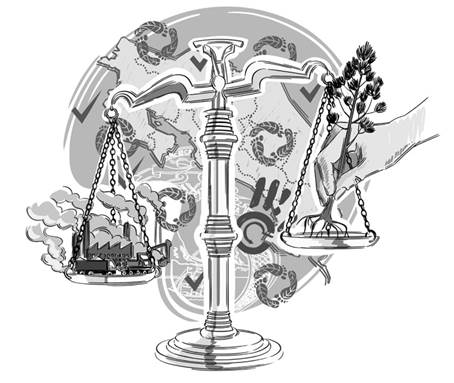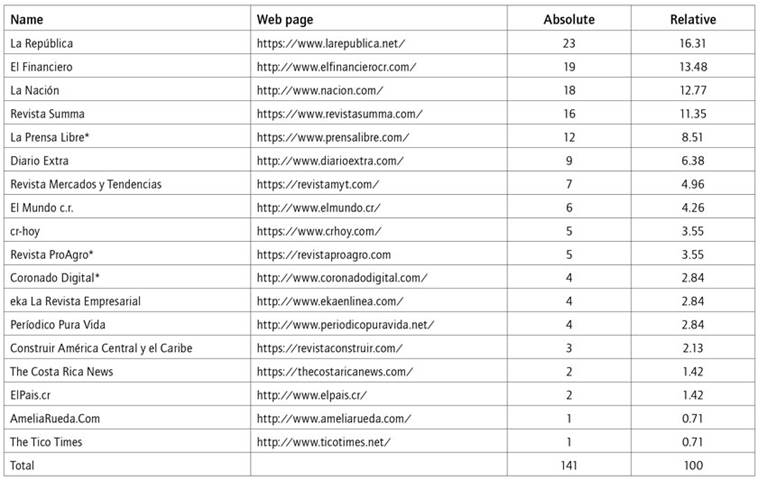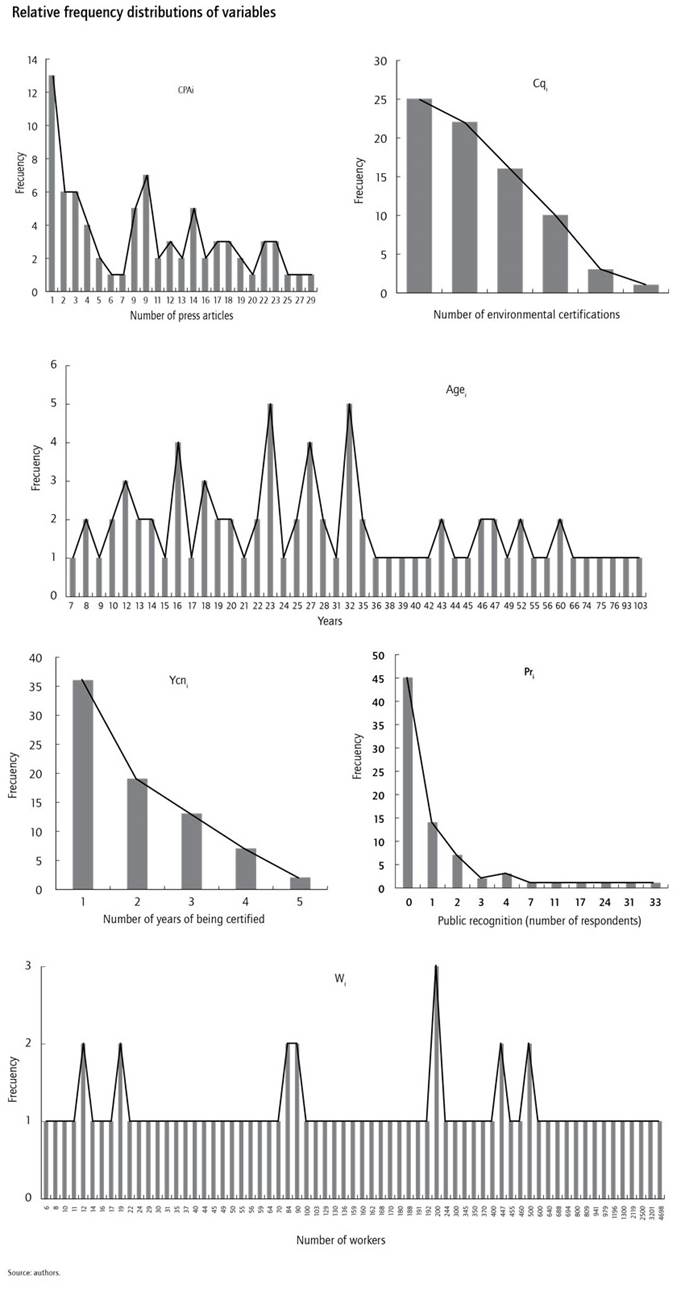Introduction
During the last decade, in line with the United Nation’s thirteenth Sustainable Development Goal (sdg), i.e., “take urgent action to combat climate change and its impacts” (United Nations, 2020), and the Paris Agreement objectives, the so-called carbon neutrality (cn) initiatives have gained a place among the most popular voluntary environmental approaches throughout the world (Falk & Hagsten 2020; Lee et al., 2016). This article focuses on one of the first public cn initiatives in the world, known as the Carbon Neutral Program (cnp) introduced in Costa Rica in 2012.
In 2007, the Costa Rican Government pledged to become one of the first nations to be carbon neutral (Ball et al., 2009; Flagg, 2018). Achieving this goal requires the commitment of the private sector through the adoption of more sustainable production systems (André & Valenciano-Salazar, 2020) and consumption patterns (Valenciano-Salazar et al., 2021). One way to promote such a commitment is by incorporating companies into voluntary initiatives such as the cnp.
Although the adoption of an environmental voluntary initiative involves costs for firms (Ho et al., 2016; Santos et al., 2016; Yiridoe et al., 2003), it can also bring important benefits in terms of improving the company’s image, enhancing visibility, social legitimacy, and public recognition. This aspect has been widely documented in the literature by authors such as Hillary (2004), Mariotti et al. (2014), Morrow and Rondinelli (2002), or Yiridoe et al. (2003), among others.1
This positive image effect can be reinforced by different actions that firms may deploy to inform their stakeholders —such as media and consumers— about their environmental efforts (Carvalho et al., 2020). Said actions include the adoption of ecolabels and environmental certifications, so that stakeholders can distinguish goods that are produced in more sustainable ways and companies that carry out more environmentally friendly production processes (Laroche et al., 2001; Valenciano-Salazar et al., 2021; Van Loo et al., 2015). Other communication channels include press releases, newsletters, awards (Aerts & Cormier, 2009; Khanna, 2001), reports, social media activity (Reilly & Larya, 2018), and companies’ websites (Bansal & Bogner, 2002; Carvalho et al., 2020; Wang, 2016).
We focus on mass media —specifically online newspapers— as a particularly important channel to communicate the environmental actions of companies and public institutions (see Carroll, 2013; Haddock-Fraser, 2012; Jonkman et al., 2020). The information published by the media is important for firm leaders (Bednar, 2012) because coverage patterns reflect (but also affect) the process of consumers’ recognition of companies. In addition to enhancing firm’s reputation (Rindova et al., 2017) and improving their image (Carroll & McCombs, 2003), the information displayed by the media can also influence investment decisions (Hamilton, 1995; Solomon et al., 2014) and consumers’ purchases (Saeed et al., 2019).2
These effects have been formally described by the media system dependency (msd) theory (Ball-Rokeach & DeFleur, 1976). Dependency relations are created when the resources or information provided by the media help individuals to achieve various objectives, such as orientation, understanding or entertainment (Zhang & Zhong, 2020). Moreover, according to Ball-Rokeach and DeFleur (1976, p. 10), the media generate cognitive, affective, and behavioral effects on people, who become heavily dependent on them for information. Attitude formation is particularly relevant when audiences rely heavily upon media information resources to keep up with their changing world. For example, media foster new attitudes about current events or issues such as the energy crisis, wars, political corruption, and environmental problems such as climate change. A cognitive effect highlighted by the authors of msd theory focuses on the role of media in agenda-setting. In business, Carroll and McCombs (2003) used the agenda setting framework to explain how media coverage (volume of reports) influences individuals’ perceptions towards firms and their most important attributes (Einwiller et al., 2010; Kiousis et al., 2007; Meijer & Kleinnijenhuis, 2006).
The Costa Rican Government has been making significant efforts to promote the cnp (minae, 2021), including media diffusion. However, to the best of our knowledge, a systematic analysis about the coverage of this program by media has not been done so far, and the relation between media coverage and consumers’ recognition of cn-certified organizations has not been studied either. We aim to fill this gap by performing a systematic search in Costa Rican newspapers about the cnp. More specifically, we focused on the news about environmental actions by cn organizations and the benefits perceived by them after joining this program. In this way, we try to assess the media visibility of cn-certified firms. We also investigate the impact of such media coverage on consumer’s recognition. To shed some light on the latter question, we conducted a survey about Costa Rica’s ability to recognize cn entities and related such ability to our measure of media visibility for these entities.
From a statistical point of view, we address two related questions. First, we wondered about the features of certified firms that determine their level of media coverage in order to identify if there is any specific profile of firm that is more prone to be cited in the newspapers in relation to its participation in the cn program. To answer this question, we categorized cn organizations in two groups: “highly cited” (those that were cited in press articles a number of times equal to or above the median) and “scarcely cited” (below the median). In addition, we examined if there were significant differences between the characteristics of both groups. Second, we wondered to what extent the fact of being cited in the press has an influence on consumers’ recognition. To this aim, interviewees were asked an open question to test their ability to recognize cn-certified organizations. Then, we investigated the different characteristics between recognized and non-recognized firms.
The remaining of the article has the following structure. After this introduction, the second section presents several elements related to the background of the cnp in Costa Rica, similar programs around the world, and the theory behind media coverage as a communication channel of ecological actions by companies. The third section presents our methodological approach, including the data sources and variables, the selection of press articles, the description of the survey and the non-parametric statistics. The fourth section presents our findings, and the last section gathers the main conclusions.
Background
The Carbon Neutrality Program (cnp) in Costa Rica
The cnp can be classified as a public voluntary program. It was introduced in Costa Rica in 2012, in accordance with the Government’s strategy of moving towards a low carbon footprint development model (André & Valenciano-Salazar, 2020; Flagg, 2018). This program seeks to encourage companies and public organizations, first, to measure their greenhouse gases (ghg) emissions and, second, to develop strategies to prevent, mitigate or compensate them (minae et al., 2019). The number of entities opting for the cn certification has noticeably increased since its introduction. In 2012, when this program started, only 2 firms adopted it. As of 2021, there were 121 certified organizations (minae, 2021), which include 8 public institutions, 6 public companies, 13 cooperatives or associations, and 94 private firms.
In this program, the ghg emissions from each organization are measured in carbon equivalent units. Every organization has three mechanisms to obtain the cn certification, namely: i) reducing the number of emissions, ii) capturing and storing emissions in carbon sinks located in its own properties, or iii) offsetting their emissions by purchasing carbon credits (Flagg, 2018; minae et al., 2019). An external certifying agency must verify that the information reported by companies is accurate and that all the information is checked by the Costa Rican Climate Change Department before issuing a declaration called “Carbon Neutral Brand” or “Carbon Neutral Certification” (minae, 2021).
Voluntary carbon neutral programs: Other experiences
All around the world, voluntary cn programs are becoming an important mechanism to decarbonize the economy. Some of these programs are developed by government agencies, including the Carbon Neutral Program by the Australian Government, the British Columbia Carbon Neutral Government Program, the Carbon Offset Funds of London, the Chilean Carbon Management Program, the New Zealand Carbon Neutral Government Program, the Ecuadorian Carbon Neutral Environmental Recognition, and the cnp in Costa Rica. Other programs, such as the Mexican Carbon Platform and iso 14064, are driven by the private sector. Finally, there are multilateral cn initiatives, such as the Climate Neutral Now program implemented by the United Nations Framework Convention on Climate Change.
Although there are differences across existing cn programs, all of them involve similar requirements. In general terms, participants need to measure their ghg emissions and act over them following some combination of three strategies: i) implementing carbon removal strategies, ii) abating emissions using green technologies, and iii) offsetting or compensating the remaining emissions by purchasing carbon credits (see United Nations Framework Convention on Climate Change, 2020).
Although there are several cn programs working throughout the world, few studies have empirically addressed their economic and environmental impacts on companies. In Queensland, Australia, Zeppel and Beaumont (2013) showed that motivations for tourist companies to participate in carbon offsetting programs were related to environmental concern, commercial benefits of climate friendly tourism, and financially supporting offset projects. Okereke (2007) argued that the first motivation underpinning companies’ carbon management programs in the u.k. is profit enhancement, especially because of cost savings and more efficient technologies, as well as improving their green reputation.
Regarding the impact of cn programs on companies’ environmental sustainability, there are mixed results. Wen-Tien (2017) found that energy-saving and carbon-reduction policies were successful in curbing carbon emissions in the Taiwan High Speed Rail Corporation. Hao et al. (2015) obtained similar findings for carbon neutral’s wastewater treatment plants in China. However, Birchall et al. (2015) concluded that carbon accounting is not necessarily credible evidence of organizational action or climate change abatement in New Zealand.
In a comparative analysis of the adoption of carbon neutral programs by public institutions in three countries —New Zealand, the United Kingdom, and Australia— Ball et al. (2009) reported that the implementation process for carbon neutrality is not sufficiently understood, there is a need to identify and critically examine the ‘offset threshold’ at which mitigation efforts cease and offsetting is adopted, and there is also an absence of evaluation of the ‘leading by example’ rationale.
In Costa Rica, André and Valenciano-Salazar (2020) concluded that the economic-strategic criteria and the environmental sustainability motive have a similar level of importance for companies when they decide to participate in the cnp. In economic-strategic terms, companies seek market differentiation, a green image, and cost savings, while the criteria of environmental sustainability are related to the reduction of emissions and damages and the saving of materials and energy.
Media coverage as a communication channel
It is well documented that improving companies’ green image and reputation is one of the main drivers for the adoption of environmental certifications and programs (Martín-de-Castro et al., 2017; Santos et al., 2016).3 To achieve this target, companies have a strong incentive to look for ways to convey information about their environmental and social behavior in order to build a good reputation (Dowling, 2001).
Reports by media about companies’ actions can affect their public recognition and corporate reputation, both positively and negatively (Graf-Vlachy et al., 2019). For example, the media can help consumers learn about companies and organizations, even those they are not familiar with (Carroll & McCombs, 2003). As Carroll (2013) argued, the news media enable people to learn about the issues they care about but are not easy to personally observe, such as corporate social responsibility, innovation, or environmental performance.
msd theory states that individuals depend on the media to reach various goals and reduce ambiguity. According to this theory, people is likely to have a dependency relationship with media, in the sense that the satisfaction of their needs or the attainment of their goals is contingent upon the information resources owned or controlled by the media (Ball-Rokeach, 1985; Ball-Rokeach & DeFleur, 1976). Strong media effects are more likely to occur in unstable or uncertain situations (Loveless, 2008), or when the information provided by the media is well developed and particularly useful for decision making (Ball-Rokeach et al., 1984; Groshek, 2011). It can be argued that these theoretical conditions hold to some extent in the setting we are addressing. The large uncertainty about climate change and the necessity to make informed decisions about cn adoption (on the firms’ side) and consumption purchases (on the consumers’ side) can render media information particularly relevant.
One of the implications of the msd theory refers to the role of media in agenda-setting. This implication has been tested in previous empirical studies showing the interdependence between firms, media, and stakeholders to get individual targets. Stakeholders rely on the news media to learn about certain dimensions of the companies’ reputation that are difficult to personally observe or experience (Carroll & McCombs, 2003; Einwiller et al., 2010; Kiousis et al., 2007; Meijer & Kleinnijenhuis, 2006). At the same time, “firms also depend on the news provided by media for the dissemination of such information that cannot be directly experienced through consumption or interaction and that lacks credibility when communicated by the firms themselves” (Einwiller et al., 2010, p. 302), as could be the case of technological changes driven by cnp adopted by companies.
Other studies use msd theory to analyze consumers’ reaction to the disclosure of environmental information by the media. Ho et al. (2015) found that consumers’ media dependency, traditional media attention, and interpersonal communication were positively associated with green buying. Saeed et al. (2019) found that information about product sustainability on social media affects consumers’ purchase behavior. Zhang and Zhong (2020) concluded that informational media use was positively associated with environmentalism. Moreover, this use of media had greater impacts on environmentalism when the information and communication infrastructure was better developed or when the real-world environmental situation was worse.
Several studies show that firms’ corporate social responsibility and environmental behavior are being increasingly covered by the media (Brown & Deegan, 1998; Carroll, 2013; Graf-Vlachy et al., 2019; Haddock-Fraser, 2012; Hamilton, 1995). This coverage is prone to modify companies, consumers and investment decisions and end up affecting a company’s performance. For example, Hamilton (1995) concluded that companies with a negative environmental performance can be penalized by media news that highlight their polluting behavior. This negative environmental information disclosed by media could be correlated with a loss of value of the company’s shares. Brown and Deegan (1998) showed that higher levels of media attention (media coverage) increase the environmental information disclosed by companies. Haddock-Fraser (2012) found that newsprint media disclose corporate environmentally sustainable development activities, and this information is consulted mainly by a segment of people who are more educated and concerned about the environment.
In this setting, it is natural to ask about the determinants of media coverage. In our specific case, is it likely that all cn-certified companies and organizations receive the same media visibility (volume of articles) or that there are asymmetries based on the firms’ characteristics? Previous research has shown that, in fact, companies’ features can influence media coverage. Corporate-brand companies are significantly more likely to find themselves of interest to the u.k. media (Haddock-Fraser, 2012). Large companies also tend to attract greater media coverage, measured by the number of employees (Jonkman et al., 2020; Meznar & Nigh, 1995) or by their financial resources (Moon & Hyun, 2014). Organization’s age is an important variable related to media coverage. Several studies show that old companies tend to have more media visibility (Carroll & McCombs, 2003; Schultz et al., 2001). The type of property is also an important variable that explains media coverage. Public organizations (companies or institutions) tend to be more scrutinized by the media than other ownership structures (Jonkman et al., 2020; Liu et al., 2010). Regarding social and environmental actions, companies with superior performance tend to receive more favorable news reporting (Haddock-Fraser, 2012), which increases firm’s equity valuation (Cahan et al., 2015).
Methodology
Primary data: Revision of press articles and consumers’ survey
We gathered some primary data and used additional data from secondary sources. The primary data include a revision of press articles and a survey to consumers. The aims of data gathering are, on the one hand, to build a measure of the media coverage of environmental actions and the benefits perceived by participants in the cnp and, on the other, to relate this coverage with consumers’ recognition.
First, we explored online press articles published in Costa Rican newspapers from January 1st, 2013, to December 31st, 2016. The sample period began in 2013 because the cnp started in 2012 and only 2 companies had achieved the certification at the end of that year. In addition, we considered that the program was not yet well known by the media in 2012. On December 2016, there were 77 organizations taking part in the cnp. We searched on “Google News” using (the Spanish version of) the keywords “Carbon Neutral Program Costa Rica,” “Carbon Neutrality Costa Rica,” and “Carbon Neutral,” adding the name of each of the companies and institutions that were part of the cnp at that time. We used the same procedure for online newspapers with the option to search for previously published news.
Only the articles that met the following two criteria were selected: first, each article must mention at least one certified entity, and second, they must refer to the actions carried out or the economic benefits perceived by firms or organizations due to the cn certification. Appendix A shows the newspapers included in the search and the number of selected articles from each of them. From the selected articles, we built an indicator of press article coverage (cpai) for each certified organization, i. This indicator measures the number of articles in which each organization is cited.
Second, between July 2017 and April 2018, after concluding the review of the press articles, we performed a survey about consumers’ recognition of environmental certifications. For the sake of consistency, it is important that the media coverage study is made before the consumer survey, since we aimed at determining to what extent the former has an impact on the latter. The survey is used for broader research purposes, not only about the cnp, but also about other environmental certifications in Costa Rica, and includes more parts that are not used in this article (see Valenciano-Salazar et at., 2021). The whole sample includes 1,191 respondents using face-to-face surveys in public places. Out of this number, we used 387 observations, which correspond to the subsample referred to the cnp. Table 1 provides details on the structure of the survey in comparison to the structure of Costa Rican population by gender and province.
Table 1 Costa Rican population over 18 years old and survey respondent distribution.
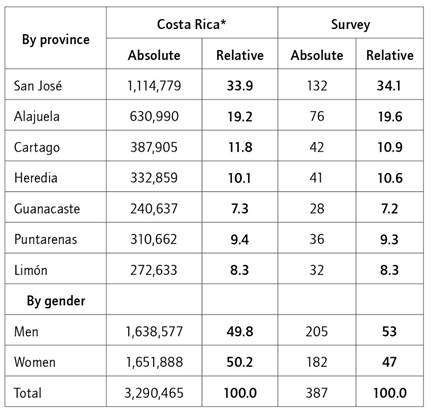
*Data obtained from Tribunal Supremo de Elecciones de Costa Rica (2017). Source: authors.
For the purpose of this study, we focused on two questions of the questionnaire: i) “Do you know what the cnp is?” and ii) “Can you name companies or institutions that achieved the cn certification? Name the ones that you remember.” We built our public recognition indicator (Pri), based on the latter question, as the number of consumers who named each company.
We grouped cn organizations into “recognized” and “unrecognized,” and we sought for differences between both groups according to their features, as well as the number of articles in which they were cited. In this way, we tried to determine if the firms and organizations that are more recognized by consumers as “carbon neutral” tend to be those more cited in the press.
Secondary sources: Company data
Apart from the primary data, we also used data from diverse sources. The list of cn organizations as of December 2016 and the year of certification for each of them were taken from the website of the Costa Rican Climate Change Department (the list of the current participants can be found in minae [2021]). There was a strong concentration towards private companies, as follows: 66 private companies, 5 cooperatives (privately owned by the shareholders), 3 public companies, 2 public agencies, and 1 college (Bar Association).
In 2017, we identified the number of environmental certifications obtained by each organization from their websites and from the Institute of Technical Standards of Costa Rica website (inteco, 2016). The age of each entity in 2017 was obtained from the websites of certified organizations and information published in newspaper articles. The media coverage of each cn organization was computed through our own inventory and analysis of press articles published between 2013 and 2016.
The number of workers per company in 2018 was collected from various sources, since there is not an available uniform database; the Institute of Statistics and Censuses of Costa Rica (inec, 2018) provided information for 65 companies, while the information for 10 other organizations was obtained from their websites, information published in articles, and directly from companies. For 2 companies it was not possible to obtain data on the number of workers. Table 2 shows the main descriptive statistics of the variables used in our study.
Table 2 Descriptive statistics of the variables.
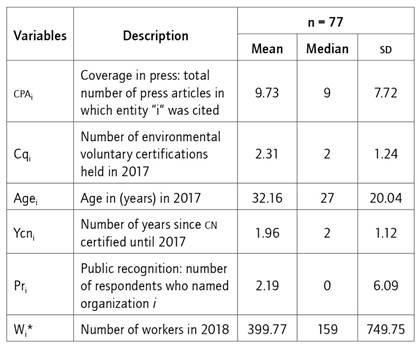
*Data available for 75 cn organizations. Source: authors.
The firms’ characteristics that we decided to focus on were selected based on two criteria: data availability and previous theoretical and empirical studies that have analyzed which features are more prone to determine companies’ visibility. See above subsection “Media coverage as a communication channel.”
Non-parametric statistics
Correlation among variables
The lack of normality of the data and the presence of outliers (see frequency distribution of variables in Appendix B) led us to use non-parametric (distribution-free) methods for the statistical analysis. First, the correlations between pairs of variables were calculated using the Spearman Correlation Coefficient (Spearman, 1904), which is a widely used non-parametric alternative to the Pearson Correlation Coefficient (Restrepo & González, 2017; Romijn & Albaladejo, 2002; Sánchez-González et al., 2017). Although correlation is not enough to demonstrate the existence of causality among variables, this analysis provides us with some intuition about the factors that are connected to visibility and public recognition.
Differences between groups of certified entities
In order to study how media coverage is connected to the attributes of cn organizations, we split them in “highly cited” and “scarcely cited” entities in press articles by making two groups above and below the median of cpai (equal to 9; see table 2) and checking how both groups differ in terms of the attributes of the certified entities (Cqi, Agei, Ycni and Wi), using the Mann-Whitney test (Conroy, 2012). The Mann-Whitney (1947) test is a widely used non-parametric test to compare differences between two independent groups. For example, Capmany et al. (2000) and Doyle et al. (2007) applied this test to compare financial and environmental variables between two groups of companies.
Then, to study how media coverage relates to consumers’ recognition (Pri), we grouped cn organizations as “recognized” (those that were named at least once by consumers in the survey) and “unrecognized.” Using the Mann-Whitney test, we checked to what extend both groups differ in terms of the variables of interest (cpai, Cqi, Agei, Ycni, and Wi).
Results and discussion
Media coverage and information disclosed
Figure 1 shows that both the number of cn organizations and the number of related articles had an increasing trend during the sample period, which seems to confirm the growing relevance of the cnp.
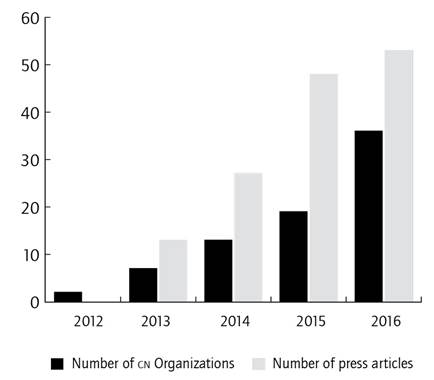
Source: authors.
Figure 1 Carbon neutral organizations certified per year and press articles identified per year in Costa Rica (2012-2016).
In the whole sample period, we found 749 citations of cn organizations in 141 press articles. On average, each entity was mentioned 9.7 times in press articles during the period, but the number of citations is not uniform, with a standard deviation of 7.72 across firms. The frequency of cn organizations by number of articles is shown in table 3. As a general observation, all certified organizations were cited at least once, and 50% of them appeared in 9 or more articles.
Table 3 Frequency distribution of Carbon Neutral entities by number of articles that cite them.
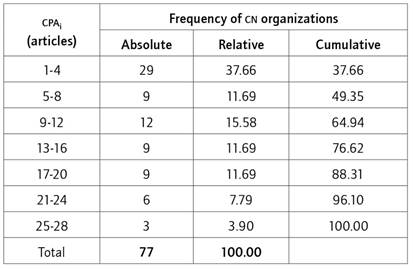
Source: authors, from press articles analysis.
The information contained in the articles can be grouped into two main categories: the first one refers to the benefits perceived by the organizations, whilst the second has to do with technological changes and other environmental actions implemented by certified organizations.
Regarding the first category, 51% of the articles mentioned some of the benefits or advantages received by the organizations for being cn-certified. Specifically, 39% of these publications revealed that entities reduced their costs or increased their productivity after obtaining the certification, 18.4% reported improvements on the organizations’ image, and 14.2% referred to market differentiation due to the cn certification. Concerning cost savings, table 4 shows the top 5 actions highlighted in press articles.
Table 4 Top 5 of cost saving actions by Costa Rican cn organizations (2013-2016).
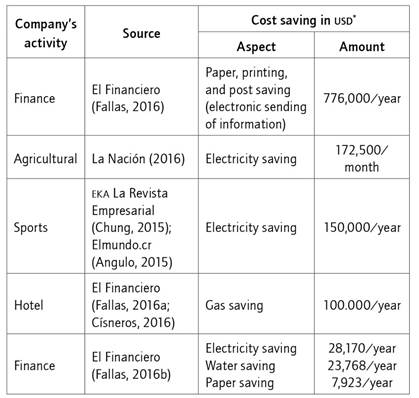
*Based on the annual average of exchange rate of the Central Bank of Costa Rica (2017).
Source: authors, from press articles analysis.
As for the second category of information, 78.7% of the collected press articles mentioned environmental actions performed by cn organizations, including technological and organizational changes. More specifically, the main reported changes were the following: 41.1% of the articles mention that organizations offset emissions through the purchase of carbon credits, 37.6% inform about the replacement of polluting inputs by cleaner ones, 27.7% refer to staff training regarding more sustainable consumption and production processes, 26.2% show how firms accomplished water use reductions or took actions to protect water basins, and 22% report reductions or substitution of fossil fuels in production and transportation processes. Finally, 16.3% of the articles refer to waste separation and recycling. Other clean production practices mentioned in the articles were reforestation programs and the installation of solar panels and light-emitting diode lamps (led lamps).
Table 5 shows the top ten investments in technological change and environmental actions reported in the newspapers, where the largest allocation of resources is related to staff training, the installation of solar panels, heat exchangers and led luminaires.
Table 5 Top ten of Costa Rican cn organizations’ investments in technological change and environmental actions reported in the press (2013-2016)
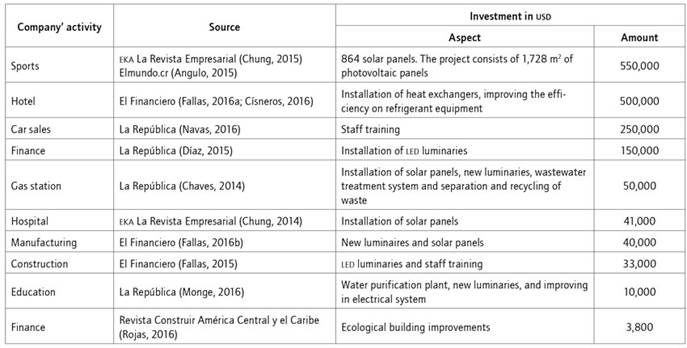
Source: authors, from press articles analysis.
As a first remark, online press articles reveal that certified companies have invested in new production and distribution technologies to reduce their carbon footprint, while the remaining ghg emissions have been offset by carbon credits. Currently, these ghg reductions and offset actions are widely featured in online newspapers (Barquero, 2020; Garza, 2019; Rodríguez, 2018; Soto, 2017). Thus, at least to some extent, cnp has been a successful sustainability management approach and, on top of that, has generated economic-strategic improvements such saving cost and enhancing the green image of participants into the program (Valenciano-Salazar et al., 2022).
The second point to highlight is the role of online newspapers as a dissemination mechanism for the cnp and the mitigation actions conducted by cn organizations. Thus, consumers interested in sustainable production processes have the possibility to read news as a mechanism to learn about the behavior of companies. This finding is in line with previous studies, such as those by Carroll and McCombs (2003), Carroll (2013), Einwiller et al. (2010), and Haddock-Fraser (2012), who found a dependence on the media to disseminate companies’ behavior and increase consumers knowledge about firms. Additionally, Ho et al. (2015) and Saeed et al. (2019) show that the information displayed by the media can influence the purchase decisions of consumers, or it could encourage individuals’ participation in environmental groups (see also Zhang & Zhong, 2020).
Correlation between the relevant variables
The Spearman correlation analysis displayed in table 6 provides a first approach to study how the different variables interact with each other. This analysis suggests that the press coverage (cpai) is positively and significantly correlated with the number of certifications (Cqi) and how long the company has been certified as cn (Ycni). Besides, the public recognition of cn organizations (Pri) is positively and significantly correlated to their newspaper coverage (cpai), the size of the company measured by the number of workers (Wi), and how long the company has been certified as cn (Ycni).
Table 6 Spearman’s correlation matrix
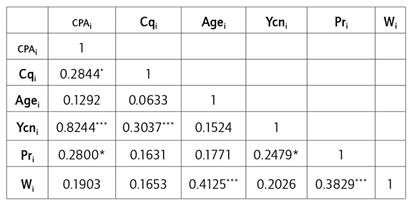
*p < 0.05; **p < 0.01; ***p < 0.001; p values in parentheses. The correlation between W and the other variables was performed for 75 cn organizations. Source: authors
Based on these correlations, in the next sections we present two related but different comparisons in statistical terms using the nonparametric Mann-Whitney test: first, we investigate the differences between “highly cited” and “scarcely cited” organizations and, second, we compare “recognized” and “unrecognized” entities.
Media coverage and organizations’ features
By noting that our measure of coverage in press articles (cpai) is positively correlated with Cqi and Ycni, we can hypothesize, on the one hand, that getting more certifications causes an accumulative positive effect on media coverage and, on the other hand, that the organizations that have held the cn certification for more years also tend to be more visible in the press. In order to confirm these assumptions, we used the Mann-Whitney test to check if there are significant differences between “highly cited” (above the median) and “scarcely cited” (below the median) entities regarding these features.
Our results confirm that there are statistically significant differences between both groups of organizations (table 7). Specifically, highly cited organizations tend to be those that obtained the cn certification before than scarcely cited ones. This result is determined by two factors. The first is because the entities that were not certified at the beginning of the cnp could not be cited as such in the newspapers. The second factor is less obvious and more interesting for our purposes: given that the cnp began in 2012, environmental sustainability actions deployed by the first certified organizations were considered as innovative and, consequently, these companies have been a reference in the media throughout the sample period.
Table 7 Mann-Whitney test for differences between highly and scarcely cited cn organizations

*p < 0.1; **p < 0.05; *** p < 0.001; Z describes the position of a raw score in terms of its distance from the mean when measured in standard deviation units; a when testing Wi ,the group sizes are 38 and 37, respectively. Source: authors
In addition, highly cited cn organizations are prone to have a larger number of environmental certifications than scarcely cited organizations. One interpretation of this result is that additional certifications may have a cumulative impact on the green image and visibility of organizations. Haddock-Fraser (2012) found that firms with superior environmental performance get more favorable media visibility. In our case, this additional information in terms of environmental certifications may help the media find out and become more interested in these companies and institutions.
Regarding age, while highly cited organizations are, on average, older than the scarcely cited, this difference is not statistically significant. In a similar fashion, Jonkman et al. (2020) did not find a statistically significant relationship between firms’ age and media coverage in the case of 100 large corporations in the Netherlands. On the other hand, it can also be surprising to some extent that we find no significant differences in terms of size between highly cited and scarcely cited organizations. This contrasts with Jonkman et al. (2020), who found out that the largest Dutch companies received more visibility on newspapers. Since our study is not focused on all the companies, but only in cn-certified ones, it seems that the size of the company becomes less important for the sake of media coverage.
Media coverage and consumers’ recognition
Our last research question has to do with the reward of firms in terms of consumers’ recognition. As discussed in the introduction, one of the aims of firms when adopting a voluntary certification is to improve their image among consumers. Thus, it seems natural to wonder to what extent the newspaper coverage that cn organizations get thanks to the certification has a reflection in terms of recognition by consumers. Additionally, we can also ask if there are other factors (besides media coverage) that generate an impact on consumers’ recognition. To answer these questions, we used the survey in which we measured the number of people who named each cn organization. According to this survey, 32 cn organizations (out of 77) were correctly named by at least one respondent —14 of these companies being named by one single respondent—, 7 companies were named by 2 respondents, and 11 companies were recognized by 3 or more.
Regarding the impact of media exposure on consumers’ recognition, the correlation analysis shown above suggests that both variables are positively correlated as expected. Moreover, the ability of consumers to identify certified firms seems to increase with the number of years that the organizations have been holding the certification.
As an additional check, we split the sample of organizations in “recognized” (Pri ≥ 1) and “unrecognized” (Pri = 0) and used the Mann-Whitney test to determine if both groups are statistically different in terms of the variables of interest (table 8). The positive correlation obtained in table 6 between media coverage (cpai) and public recognition (Pri) is confirmed by the Mann-Whitney test, which reveals that newspaper coverage is significantly different between both groups, thus the test confirms that recognized cn organizations tend to be those that have been cited more often in the press. This evidence is in line with previous studies such as those by Brown and Deegan (1998), Carroll (2013), Graf-Vlachy et al. (2019) or Haddock-Fraser (2012), who showed that media is one of the main channels by which organizations can gain public recognition as a reward for their ecological actions. Our finding is also consistent with the frequent use of the Internet and cell phones in Costa Rica, which facilitates the dissemination of online articles. According to the World Bank (2018), 100% of the Costa Rican population has access to electricity, mobile cellular subscriptions (per 100 people) are about 180, and 72% of the citizens have used the Internet (from any location) in the last 3 months.
Table 8 Mann-Whitney test for differences between recognized and unrecognized cn organizations

*p < 0.1; **p < 0.05; ***p < 0.001; a for Wi variable there are two less individuals in unrecognized organizations sub-group. Source: authors.
As expected, “recognized organizations” tend to be larger in terms of number of employees (Wi), even though (as we concluded above) larger organizations do not appear significantly more often in the press. Regarding other differences between both groups, recognized entities also tend to be older and those that obtained the cn certification sooner than unrecognized entities.
Conclusions
The cnp has been an important initiative of the Costa Rican government to support the aim of becoming a carbon neutral country. Since the introduction of the cnp, the media have reported the environmental actions deployed by participating companies, which seems to cooperate with the government’s purpose of disseminating this program. Our results are consistent with the common belief that communication media have become an important channel to inform about green companies and their environmental behavior.
Some of our results can be read in the light of the msd theory, in the sense that we observe a dependence on online newspapers both by the certified entities and consumers. Although certified organizations may use a cn logo (eco-label) in their facilities to demonstrate that they are part of the cnp, many of their environmental actions may be unknown to consumers. The media, and specifically online newspapers, can work as an important dissemination mechanism to transmit information about the environmental actions carried out by cn organizations to the consumers. This belief is reinforced by the positive correlation identified between media coverage and consumers’ recognition and the Mann-Whitney test, which confirms that recognized organizations tend to have more visibility in online news. However, it is important to bear in mind that more than half of the organizations (45 out of 77) were not named by any consumer. Therefore, it is also fair to conclude that there is still a long way to go in the communication of environmental initiatives of firms to the society.
There is an important inertia effect in terms of media coverage and firms’ features. The fact that highly cited organizations tend to be those with a higher number of certifications seems to imply that firms more actively engaged in environmental actions also tend to be more visible, and it is natural to expect that this effect also works the other way around. When companies are rewarded in terms of more coverage, probably they will feel more incentivized to get more engaged, which can be seen as a virtuous circle.
It may come as a surprise that we did not find any significant differences between highly cited and scarcely cited organizations in terms of age or size. Nevertheless, these features do matter, in statistical terms, for the sake or recognition, since recognized organizations tend to be older and larger. From these results we can conclude, on the hand, that older firms can enjoy stronger loyalty effect from consumers that are concerned about their environmental actions (it is important not to forget that we are dealing only with cn-certified firms). On the other hand, there seems to be some inertia mechanism in terms of size: bigger firms tend to be more recognized by consumers and this recognition, in turn, is probably an important mechanism to help firms grow bigger. The fact that “recognized organizations” tend to be larger even if they do not appear significantly often in the press, suggests that larger firms tend to be more recognized per se, without the need of receiving larger media coverage.
The fact that recognized entities also tend to be those that obtained the cn certification sooner than unrecognized entities probably means that there is a reward in terms of public recognition for companies that took the risk of taking part in the program earlier. An important conclusion can be drawn from this result in terms of firms’ policy. Taking the lead in terms of environmental action can pay in terms of consumers’ appreciation.
Finally, our study provides some additional insights on the effects of the cnp programs on certified organizations. According to our press articles inventory, the most common benefits for cn organizations were cost saving or increasing productivity, improvements in the organizations’ image, and market differentiation. Online newspapers also report that cn organizations invested in new technologies and took actions to improve their environmental performance. Thus, to some extent, our study supports the claim that cnp is a flexible and effective instrument of environmental policy that could contribute to improve both the environmental and economic management of the participants.














